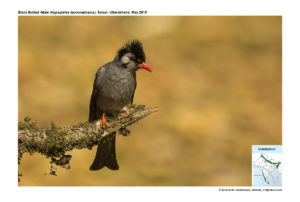
Black Bulbul Hypsipetes leucocephalus
Etymology :
- Hypsipetes : Greek word hupsi – high; petes -flyer. { high flyer}
- Leucocephalus: Greek word leukos- white; kephalos –headed { white headed}
Vernacular Name : Hindi: Kali bulbul, Kash: Wan/Kruhun bulbul, H.P.: Darkal, U.P.: Ban bakra, Pahari: Kaki, Lepcha: Phaki-pho, Cachar: Dao-bulip gashim, Mar: Kala bulbul, Krushna govatsak, Ta: Karuppu kondai kuruvi, Mal: Myna-bulbul, Sinh: Kalu kondaya
Distribution in India: Resident Himalayan foothills and North East of India
Description: Size of 24-25 cm. The body plumage ranges from slate grey to shimmering black, depending on the race. The beak, legs, and feet are all orange and the head has a black fluffy crest. Sexes are similar in plumage.
Habitat: It is found in broad-leaved forests, cultivation and gardens mainly in hilly areas, but Himalayan populations are known to sometimes descend into the adjoining plains in winter
Food Habits: Black bulbuls feed mainly on seeds and insects, and they are often seen in small groups, either roosting or flying about in search of food. They are particularly fond of berries. They are known to feed on a wide range of berries including Celtis, Rosa, Melia and Ehretia in the Himalayas.[13] They feed on the nectar of Salmalia, Erythrina, Rhododendron and other species. They make aerial sallies for insects.
Breeding Habits: The breeding season is April-July .The nest is a cup placed in a fork and made from grasses, dry leaves, mosses, lichens and cobwebs. The lining is made up of ferns, rootlets and other soft material. Both sexes participate in nest construction. Two or three eggs form the usual clutch. The eggs hatch after an incubation period of 12 to 13 days and the chicks fledge after about 11 or 12 days.